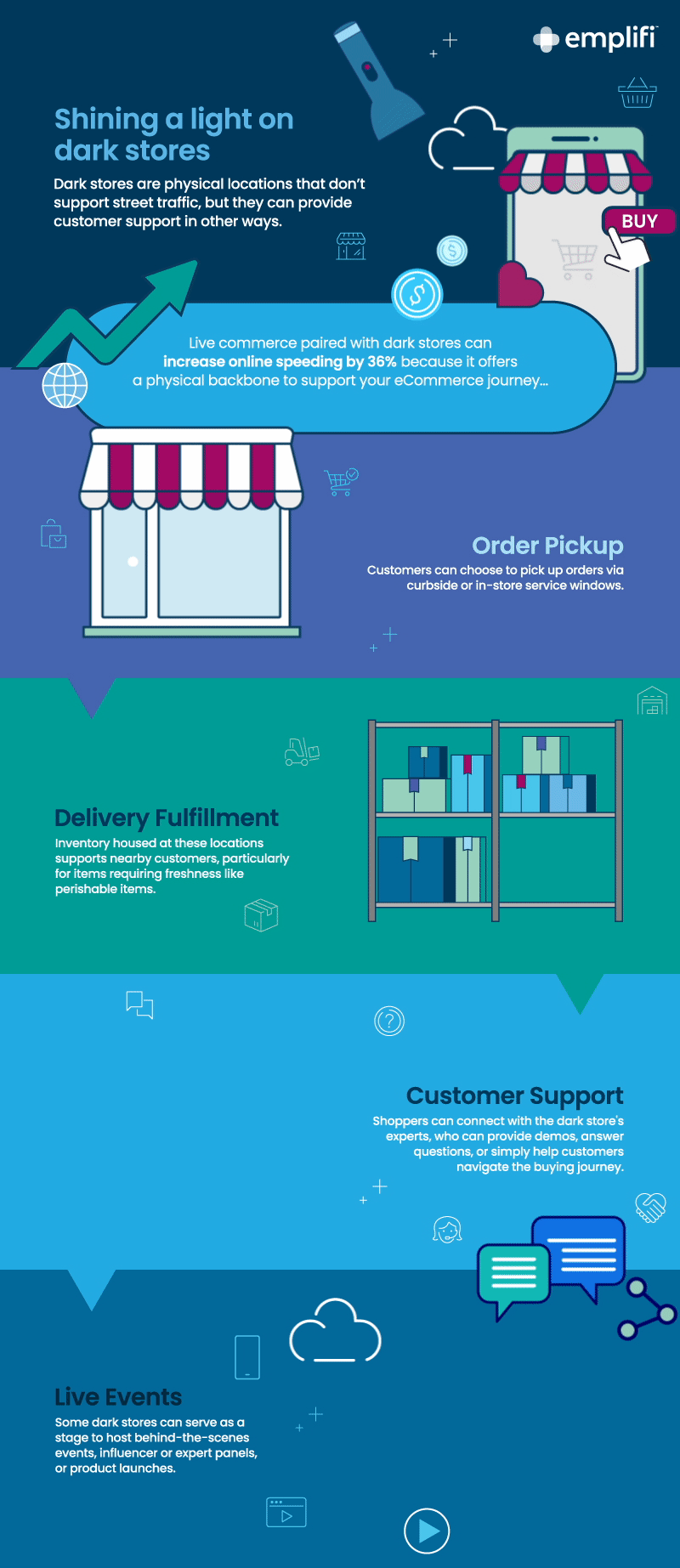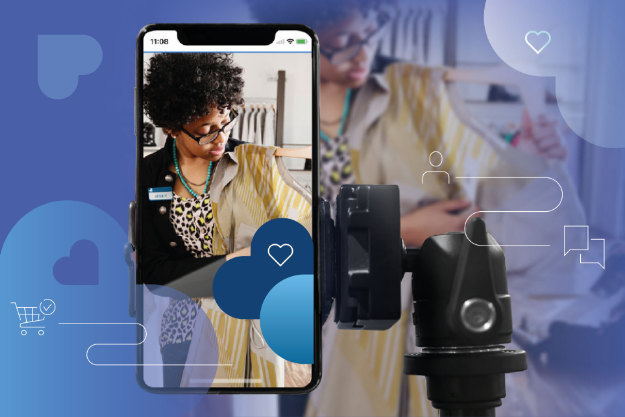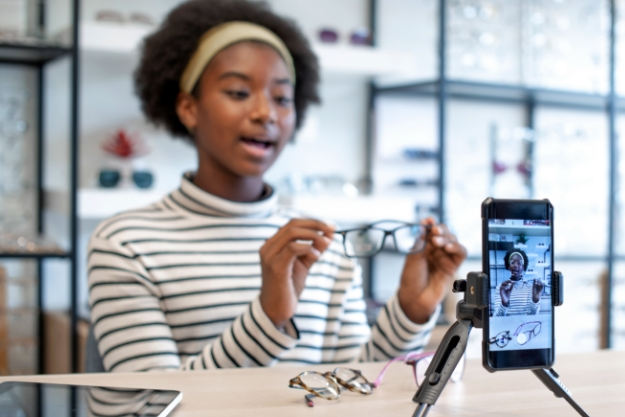There’s a gap in your brand’s eCommerce strategy, but the solution is already hidden within the supply chain. And it has the potential to increase online spending by 36%.
Select brands are now utilizing “dark stores” — a remote store location dedicated to online customer engagement, fulfillment, and support — to support live video commerce. This merger of physical and digital is the natural result of a post-pandemic consumer.
As retail locations went dark due to pandemic economic pressures, some never reopened, and others, smartly, found a new purpose. Fulfillment became a natural use of physical locations that “went dark” as foot trafic dwindled and customer preferences shifted online.
Today’s consumer expects a seamless customer experience from physical showroom to digital shopping cart, and they want brands to react quickly to their needs. Fifty-two percent of customers demand a response from brands within an hour, and they are 2.4 times more likely to stay with a brand when they receive answers quickly.
How can brands keep pace with a consumer who demands a shopping experience to support their schedule and not just the hours of a dedicated physical store? Enter the dark store, a perfect stage to support the rise of live commerce.
Live commerce sales within the United States reached an estimated $17 billion in 2022, and by 2026, that revenue is expected to triple to approximately $55 billion. McKinsey & Company predicts that live commerce-related sales could represent 10 to 20% of all eCommerce by the same year.
In that expansion, dark stores have a key role to play. Emplifi Live Commerce (previously Go Instore) uncovered that clients using its live video shopping technology have seen their average order value (AOV) increase by 200%.
Let’s explore how dark stores can support fulfilling live customer experiences.

What is a dark store?
Dark stores are physical locations within a real estate footprint that support fulfillment instead of in-person sales. These micro-fulfillment centers offer companies inventory space within areas which, when strategically deployed, are typically nestled among a target customer base.
In many cases, they even look like stores. While the concept exploded during the pandemic due to the rise of same-day delivery – particularly among grocers and consumer goods – some brands in the United Kingdom used a version of dark stores as early as the 2000s, setting up stock replenishment locations paired with existing warehouses.
The concept extends to other industries, supporting restaurants through “ghost kitchens,” as thousands of consumers each day order pad thai for lunch or late-night Doritos without ever being physically able to visit the place their food originates from.
Historically, the fulfillment aspect has been the most common use of these locations. A lack of customer access means the space is typically functional in design, cheaper to operate than a full-service store, and adaptable to shifting market demands. Inventory is easier to track, perishable goods are better managed, and customers can still interact with these spaces through curbside or store pickup.
Why are dark stores helpful for live commerce?
Live commerce allows brands to reach an unlimited audience of interested shoppers. Dark stores can provide the physical backbone to support that interest.
Through dark stores, products are accessible online to all potential consumers at any hour of the day. Across a brand’s supply chain, they can serve multiple purposes, but they immediately create the opportunity to align a network of support for live shopping.
One-to-one live shopping: Brands can utilize dedicated teams within dark stores to support personal, consultative customer interactions. Potential buyers can ask questions, view demos, and match their specific needs with a network of potential brand ambassadors to address quickly and efficiently. Not sure if that running shoe matches your foot’s arch? Discuss it live with a product expert seasoned in distance running. Does the Chicago-based customer only speak Polish? Route the video call to a dark store in Warsaw.
One-to-many livestream shopping: These dedicated fulfillment centers can also support broadcasts for product demos, behind-the-scenes sessions, launches, or expert insights. In this path, your potential shoe customer may catch a co-branded session with a former Olympian before transitioning down to a one-on-one video session supported by associates who could be located at a separate dark store.
Dark stores paired with live commerce support a seamless customer experience regardless of your approach. The key is that your products and services are available 24/7 through digital technology, while dark stores, based on location and inventory, help your brand connect directly with any potential customer need in a timely, efficient, and engaging way.
This works particularly well for eCommerce-only businesses. Companies like Orbit Baby – who utilizes Emplifi Live Advisor (one-to-one) and Live Stream (one-to-many) products – can deliver a robust customer experience that engages customers and supports their needs despite no dedicated physical stores.

How can brands with dark stores get started with live commerce?
Aligning your product with the right audiences is pivotal for live commerce success. While all consumer preferences have shifted post-pandemic, millennials (63% of their influences) and Gen Z (75%) are the leaders in looking to social media, experts, celebrities, influences, and online reviews to guide their purchase of a product or brand. Those numbers should only continue to grow, and by 2030, millennials will account for half of the population globally.
Live commerce may not currently be part of your eCommerce strategy, but its relevance will increase each passing quarter. How do you get started?
Evaluate your footprint
It’s time to make the most out of your brick-and-mortar assets. Are dark stores currently part of your supply chain? Which stores or locations could pivot to serve digital versus foot traffic? What types of associates or brand ambassadors work across each location?
The success of dark stores benefits from proximity to customers and transportation, and there are considerations for how to balance retail locations with regional distribution centers. These details build the foundation for your live commerce customer journey.
Select a technology platform
Live commerce combines video, social, and instant purchasing, so it’s critical that your solution matches your requirements. Your platform must provide a seamless experience for customers while connecting with your brand’s technology stack to track inventory, quickly connect purchases, and align customer service, if needed. If these elements don’t work together, your customer experience breaks down as consumers cross channels.
Fortunately, this part of the process funds itself. According to a study conducted by Forrester Consulting on behalf of Emplifi, brands that utilize Emplifi Live Commerce realized a 306% return on investment over three years.
Align your support team
Companies rise and fall based on how they handle customer interactions. Authentic, empathetic interactions — like this Dutch supermarket creating a “chat checkout” for elderly customers — tend to boost customer loyalty and experience. Poor interactions, on the other hand, will have customers avoiding checkouts altogether, as our research has shown that four out of five consumers indicate they would leave a brand after as few as two poor experiences.
That’s why people are perhaps the most important aspect of live commerce. Your brand must align a physical footprint of goods and services with potential customer needs, time zones, and FAQs. But it’s your people who perform on the blended stage of dark store and live commerce technology. Creating dedicated support for customers during their online shopping experience is an investment, but also a differentiator.
You can get started quickly implementing live commerce utilizing in-store associates like Bonobos — with the right solutions and training — and shift to a dark store model once your network is prepared.
Whatever model you choose, associates, brand ambassadors, and customer support must work together to bring live commerce to life within dark stores. This creates a seamless experience across the customer journey whether in-person or on a video call.
Determine a live commerce approach
The best approach to live commerce really depends on your business objectives, audience, product, and how you activate that strategy. But it’s fair to say that engaging brands tend to keep people interested, and seamless customer experiences keep them coming back.
Live commerce is a sizable opportunity for any eCommerce strategy due to the continued evolution of customer behaviors, and dark stores can be the stage for that engagement and experience.
For a one-to-one live shopping model, it’s critical that brand ambassadors are deeply knowledgeable about your product and authentic representatives of your values and culture. Dark stores support this model as virtual call centers or showrooms with inventory available for demo or delivery.
For one-to-many, the importance of well-crafted demos, compelling experts and interviews, and a strong programming model fuels each session. In this model, dark stores exist as the sound stage, helpful for production and performance while not interrupting in-person shopping at other stores.
Amplify your live commerce
Don’t forget to market your marketing. Live commerce, in either format, requires awareness of its capabilities, value, and customer impact. This naturally applies to live-streamed events featuring experts or influencers, but don’t forget to make current or potential customers aware of this human aspect of your business.

Get started with live commerce
The future of dark stores and live commerce is bright. It’s a trend that’s already mature in Asia, with brands like HappyFresh using dark stores to boost an efficient shopping experience in Singapore, and companies like Alibaba showing brands what’s possible through live commerce. The logistics behemoth used live commerce to generate $7.5 billion in total transactions in the first 30 minutes of the brand’s Singles’ Day event in 2020, which included everything from mobile phone deals to discounts on Amusement Park Electric Bumper Cars.
Certainly, there aren’t many companies with the scale of Alibaba, but the success of live commerce really starts with a single customer. Brands now have the ability to virtually connect with customers through individual experiences that mirror what’s possible in-store, directly address any potential needs, and grow loyalty one positive interaction at a time.
As your audience and reach increase, consider dark stores as a potential stage, foundation, and touchpoint for live commerce for your brand. Learn how Emplifi’s live commerce solutions can enable your dark stores to support advanced eCommerce strategies. Speak with an Emplifi expert today.

































